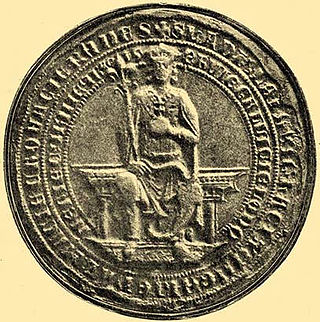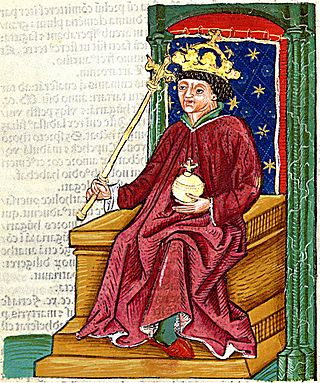
Andrew II, also known as Andrew of Jerusalem, was King of Hungary and Croatia between 1205 and 1235. He ruled the Principality of Halych from 1188 until 1189/1190, and again between 1208/1209 and 1210. He was the younger son of Béla III of Hungary, who entrusted him with the administration of the newly conquered Principality of Halych in 1188. Andrew's rule was unpopular, and the boyars expelled him. Béla III willed property and money to Andrew, obliging him to lead a crusade to the Holy Land. Instead, Andrew forced his elder brother, King Emeric of Hungary, to cede Croatia and Dalmatia as an appanage to him in 1197. The following year, Andrew occupied Hum.

Stephen V was King of Hungary and Croatia between 1270 and 1272, and Duke of Styria from 1258 to 1260. He was the oldest son of King Béla IV and Maria Laskarina. King Béla had his son crowned king at the age of six and appointed him Duke of Slavonia. Still a child, Stephen married Elizabeth, a daughter of a chieftain of the Cumans whom his father settled in the Great Hungarian Plain.

Ladislaus IV, also known as Ladislaus the Cuman, was King of Hungary and Croatia from 1272 to 1290. His mother, Elizabeth, was the daughter of a chieftain from the pagan Cumans who had settled in Hungary. At the age of seven, he married Elisabeth, a daughter of King Charles I of Sicily. Ladislaus was only 9 when a rebellious lord, Joachim Gutkeled, kidnapped and imprisoned him.

Ladislaus I, also known as Saint Ladislas, was King of Hungary from 1077 and King of Croatia from 1091. He was the second son of King Béla I of Hungary and Richeza of Poland. After Béla's death in 1063, Ladislaus and his elder brother, Géza, acknowledged their cousin Solomon as the lawful king in exchange for receiving their father's former duchy, which included one-third of the kingdom. They cooperated with Solomon for the next decade. Ladislaus's most popular legend, which narrates his fight with a "Cuman" who abducted a Hungarian girl, is connected to this period. The brothers' relationship with Solomon deteriorated in the early 1070s, and they rebelled against him. Géza was proclaimed king in 1074, but Solomon maintained control of the western regions of his kingdom. During Géza's reign, Ladislaus was his brother's most influential adviser.

Géza I was King of Hungary from 1074 until his death. He was the eldest son of King Béla I. His baptismal name was Magnus. With German assistance, Géza's cousin Solomon acquired the crown when his father died in 1063, forcing Géza to leave Hungary. Géza returned with Polish reinforcements and signed a treaty with Solomon in early 1064. In the treaty, Géza and his brother Ladislaus acknowledged the rule of Solomon, who granted them their father's former duchy, which encompassed one-third of the Kingdom of Hungary.

The King of Hungary was the ruling head of state of the Kingdom of Hungary from 1000 to 1918. The style of title "Apostolic King of Hungary" was endorsed by Pope Clement XIII in 1758 and used afterwards by all monarchs of Hungary.

Coloman the Learned, also the Book-Lover or the Bookish was King of Hungary from 1095 and King of Croatia from 1097 until his death. Because Coloman and his younger brother Álmos were underage when their father Géza I died, their uncle Ladislaus I ascended the throne in 1077. Ladislaus prepared Coloman—who was "half-blind and humpbacked", according to late medieval Hungarian chronicles—for a church career, and Coloman was eventually appointed bishop of Eger or Várad in the early 1090s. The dying King Ladislaus preferred Álmos to Coloman when nominating his heir in early 1095. Coloman fled from Hungary but returned around 19 July 1095 when his uncle died. He was crowned in early 1096; the circumstances of his accession to the throne are unknown. He granted the Hungarian Duchy—one-third of the Kingdom of Hungary—to Álmos.

Béla III was King of Hungary and Croatia between 1172 and 1196. He was the second son of King Géza II and Géza's wife, Euphrosyne of Kiev. Around 1161, Géza granted Béla a duchy, which included Croatia, central Dalmatia and possibly Sirmium. In accordance with a peace treaty between his elder brother, Stephen III, who succeeded their father in 1162, and the Byzantine Emperor Manuel I Komnenos, Béla moved to Constantinople in 1163. He was renamed to Alexios, and the emperor granted him the newly created senior court title of despotes. He was betrothed to the Emperor's daughter, Maria. Béla's patrimony caused armed conflicts between the Byzantine Empire and the Kingdom of Hungary between 1164 and 1167, because Stephen III attempted to hinder the Byzantines from taking control of Croatia, Dalmatia and Sirmium. Béla-Alexios, who was designated as Emperor Manuel's heir in 1165, took part in three Byzantine campaigns against Hungary. His betrothal to the emperor's daughter was dissolved after her brother, Alexios, was born in 1169. The emperor deprived Béla of his high title, granting him the inferior rank of kaisar.

The Kingdom of Croatia entered a personal union with the Kingdom of Hungary in 1102, after a period of rule of kings from the Trpimirović and Svetoslavić dynasties and a succession crisis following the death of king Demetrius Zvonimir. With the coronation of King Coloman of Hungary as "King of Croatia and Dalmatia" in 1102 in Biograd, the realm passed to the Árpád dynasty until 1301, when the (male) line of the dynasty died out. Then, kings from the Capetian House of Anjou, who were also cognatic descendants of the Árpád kings, ruled the kingdoms. Later centuries were characterized by conflicts with the Mongols, who sacked Zagreb in 1242, competition with Venice for control over Dalmatian coastal cities, and internal warfare among Croatian nobility. Various individuals emerged during the period, such as Paul I Šubić of Bribir, who was representing the most powerful Croatian dynasty at the time, the Šubić noble family. These powerful individuals were on occasion able to de facto secure great deal of independence for their fiefdoms. The Ottoman incursion into Europe in the 16th century significantly reduced Croatian territories and left the country weak and divided. After the death of Louis II in 1526 during the Battle of Mohács and a brief period of dynastic dispute, both crowns passed to the Austrian House of Habsburg, and the realms became part of the Habsburg monarchy.

Emeric, also known as Henry or Imre, was King of Hungary and Croatia between 1196 and 1204. In 1184, his father, Béla III of Hungary, ordered that he be crowned king, and appointed him as ruler of Croatia and Dalmatia around 1195. Emeric ascended the throne after the death of his father. During the first four years of his reign, he fought his rebellious brother, Andrew, who forced Emeric to make him ruler of Croatia and Dalmatia as appanage.

Béla the Blind was King of Hungary and Croatia from 1131 to 1141. He was blinded along with his rebellious father Álmos on the order of Álmos's brother, King Coloman of Hungary. Béla grew up in monasteries during the reign of Coloman's son Stephen II. The childless king arranged Béla's marriage with Helena of Rascia, who would become her husband's co-ruler throughout his reign.

Ladislaus II or Ladislas II was King of Hungary and Croatia between 1162 and 1163, having usurped the crown from his nephew, Stephen III.

Stephen III was King of Hungary and Croatia between 1162 and 1172. He was crowned king in early June 1162, shortly after the death of his father, Géza II. However, his two uncles, Ladislaus and Stephen, who had joined the court of the Byzantine Empire, challenged his right to the crown. Only six weeks after his coronation, the Byzantine Emperor Manuel I Komnenos launched an expedition against Hungary, forcing the Hungarian lords to accept Ladislaus' rule. Stephen sought refuge in Austria, but returned and seized Pressburg. Ladislaus, who died on 14 January 1163, was succeeded by Stephen's younger uncle and namesake, Stephen IV, without resistance, but his rule was unpopular. The young Stephen defeated his uncle on 19 June 1163 and expelled him from Hungary.

Andrew III the Venetian was King of Hungary and Croatia between 1290 and 1301. His father, Stephen the Posthumous, was the posthumous son of Andrew II of Hungary although Stephen's older half brothers considered him a bastard. Andrew grew up in Venice, and first arrived in Hungary upon the invitation of a rebellious baron, Ivan Kőszegi, in 1278. Kőszegi tried to play Andrew off against Ladislaus IV of Hungary, but the conspiracy collapsed and Andrew returned to Venice.
The Duchy or Ducatus is the denomination for territories occasionally governed separately by members (dukes) of the Árpád dynasty within the Kingdom of Hungary in the 11th-12th centuries. The symbol of the ducal power was a sword, while the royal power was represented by the crown.

Béla of Macsó was a member of the Olgovichi clan. He was Duke of Macsó (1262–1272) and of Bosnia (1266/1271–1272); and thus he governed the southern provinces of the Kingdom of Hungary.
The "Lands of the Hungarian Crown" was the titular expression of Hungarian pretensions to the various territories that the king of Hungary ruled nominally or absolutely.
Géza was a Hungarian royal prince and the youngest son of the King Géza II of Hungary. Prince Géza was brother to the Kings Stephen III and Béla III of Hungary. He was a pretender to the Hungarian throne against Béla III, but he was imprisoned from 1177 to 1189. He traveled to the Holy Land during the Third Crusade with an army of 2,000 Hungarian warriors.

The Banate of Macsó or the Banate of Mačva was an administrative division (banate) of the medieval Kingdom of Hungary, which was located in the present-day region of Mačva, in modern Serbia.

In the Late Middle Ages, the Kingdom of Hungary, a country in Central Europe, experienced a period of interregnum in the early 14th century. Royal power was restored under Charles I (1308–1342), a scion of the Capetian House of Anjou. Gold and silver mines opened in his reign produced about one third of the world's total production up until the 1490s. The kingdom reached the peak of its power under Louis the Great (1342–1382) who led military campaigns against Lithuania, southern Italy and other faraway territories.















